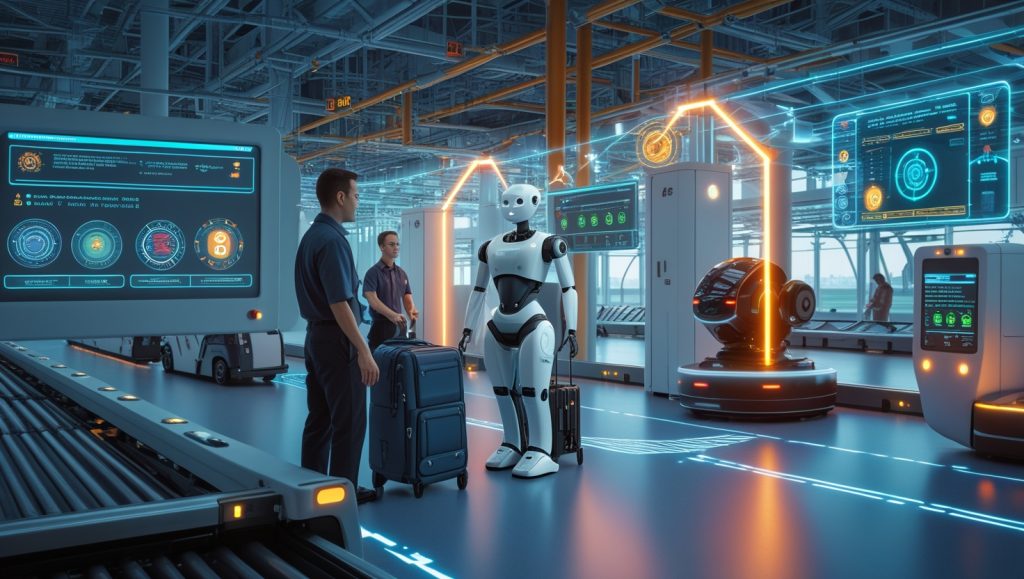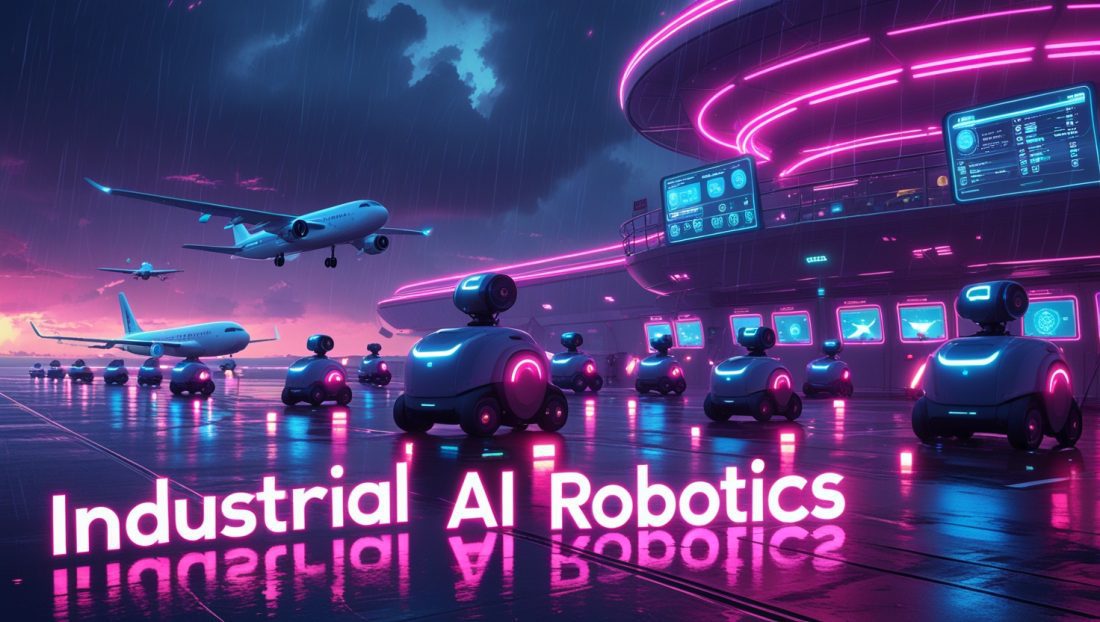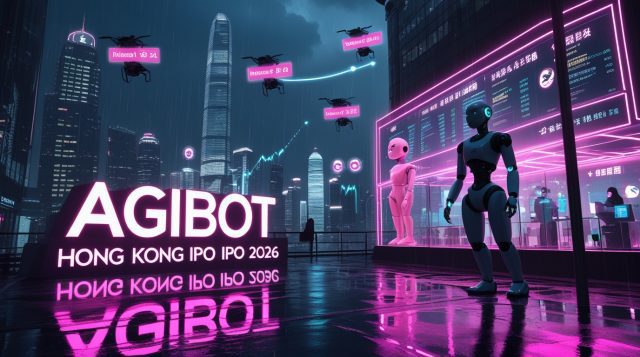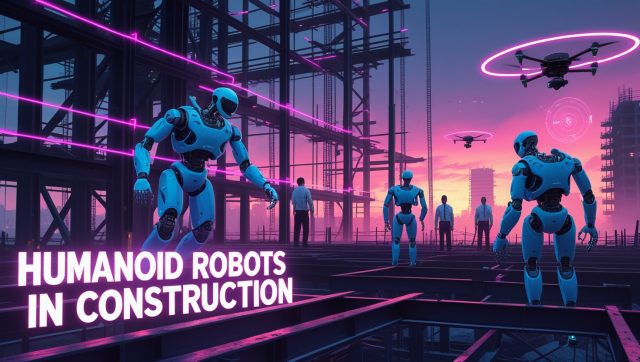Why Your Airport’s Future Depends on Smart Robotics Today
The scene at Munich Airport last winter stuck with me: A snowstorm had grounded hundreds of flights, yet amid the chaos, a fleet of autonomous tugs glided across the tarmac, moving baggage with eerie precision. While stranded passengers grumbled about delays, these tireless machines prevented a full operational collapse. This fictional vignette illustrates a seismic shift—Industrial AI Robotics isn’t just optimizing airports; it’s becoming their operational backbone.
With global air travel predicted to double to 8.2 billion passengers by 2037, traditional logistics models are buckling. The answer? An ecosystem of intelligent robots powered by Industrial AI—a fusion of machine learning, computer vision, and real-time data analytics that enables systems to learn, adapt, and execute complex tasks autonomously.
1. The Top 5 Industrial AI Robotics Systems Redefining Airport Logistics
1.1 AI-Driven Baggage Handling Robots
How they work: These systems combine 3D depth-sensing cameras, RFID tracking, and pathfinding algorithms to sort, route, and load baggage 50% faster than manual methods. Munich Airport’s BagBOT uses robotic arms with adaptive grippers to handle irregularly shaped items. For a deeper look at how advanced grippers are revolutionizing robotics, explore Force-Sensitive Grippers Redefine Touch in Robotics.
Impact: Reduces mishandled baggage by 30% while operating 24/7. At Cincinnati/Northern Kentucky International Airport, Auto-DollyTug autonomous tractors cut baggage transfer times by 40% during peak hours.
1.2 Autonomous Aircraft Service Robots
Nordic Dino Robotics exemplifies this category. Their exterior cleaning robots use AI vision to map aircraft contours, applying precise chemical/water ratios. This eliminates human exposure to toxic cleaners and reduces water usage by 20%.
Industry Insight: “Robotic cleaning isn’t about replacing humans—it’s about removing them from hazardous tasks like working at heights or handling carcinogens,” says Veronika Andrianovaite of Nordic Dino.
1.3 Predictive Maintenance Robots
Fraport’s AI-powered drones perform overnight airframe inspections using thermal imaging and vibration sensors. Machine learning algorithms compare data against failure pattern libraries to flag issues days before they cause delays. To understand how predictive maintenance is transforming factory efficiency, see Why Predictive Maintenance AI Leads Factory Efficiency in 2025.
Data Impact: At Frankfurt Airport, this system slashed unplanned maintenance by 62% and reduced inspection labor costs by $1.2M annually.
1.4 Inventory Management Swarm Robots
Vanderlande’s AIRBOT units are warehouse-sized solutions. These autonomous mobile robots (AMRs) use swarm intelligence to:
- Dynamically map storage zones
- Retrieve spare parts via barcode scanning
- Optimize stock rotation using expiration date tracking
During trials at Schiphol, swarm robots reduced parts retrieval time from 45 minutes to under 7. For insights into how swarm intelligence is advancing robotics, check out Ways Humanoid Robot Swarm Intelligence.
1.5 Passenger Flow Optimization RobotsSoftBank’s Pepper robots deployed at Changi Airport use:
SoftBank’s Pepper robots deployed at Changi Airport use:
- Emotion recognition to detect confused passengers
- Multilingual NLP for real-time wayfinding
- Predictive analytics to redirect foot traffic from congested zones
Post-implementation, terminal navigation queries to human staff dropped 57%
Table: Performance Metrics of Leading Airport Robotics Systems
| System Type | Throughput Gain | Error Reduction | ROI Timeframe |
|---|---|---|---|
| AI Baggage Handlers | 40-50% | 25-30% | 18-24 months |
| Aircraft Service Bots | 3x faster cleaning | N/A | 36 months |
| Predictive Maintenance | 62% fewer delays | 80% fewer false positives | 12 months |
| Swarm Inventory Bots | 6x retrieval speed | 99% inventory accuracy | 9 months |
2. The Industrial AI Engine: How Machine Learning Transforms Robotics
Industrial AI Robotics moves beyond programmed responses into adaptive cognition. Three architectures enable this:
2.1 Neural Networks for Real-Time Decision Making
Singapore’s Changi Airport uses IBM Watson-powered robots that ingest data from:
- IoT sensors (conveyor speeds, baggage weights)
- Weather APIs
- Flight delay databases
Their neural nets continuously reprioritize baggage routing. During a 2024 system failure, these bots rerouted 2,100 bags in 8 minutes—a human team would need 90+ minutes.
2.2 Digital Twins for Simulation Training
Before deploying physical robots, airports like Incheon run millions of simulations in virtual replicas. Their cargo robot “twins” experience scenarios like:
- Monsoon-level rain interference
- Conveyor belt jams
- RFID signal collisions
This training slashes real-world error rates by up to 73%.
2.3 Edge Computing for Latency-Free Response
SITA’s robotics controllers process data locally via edge devices rather than cloud servers. When a baggage robot detects a suspicious item, analysis happens in 0.2 seconds versus 8+ seconds via cloud—critical for security responses. Learn more about edge computing’s role in industrial optimization at TechTarget’s guide to edge AI advancements.
3. Market Leaders Driving Adoption
3.1 Vanderlande Industries
Their Bagflow system integrates robotic arms, scanners, and AGVs into one AI-coordinated ecosystem. Helsinki Airport saw 18% faster transfer times despite 30% more passenger volume after implementation.
3.2 Siemens Logistics
The CapacityPlus Suite uses reinforcement learning to optimize cargo loading. Algorithms calculate weight distribution, hazardous material segregation, and unload sequencing. Lufthansa Cargo reported 22% better space utilization.
3.3 Daifuku Co., Ltd.
RoboTerminal solutions automate 90% of air freight handling. Machine vision identifies package dimensions, while AI allocates storage positions based on flight schedules and retrieval urgency
Table: Airport Robotics Market Growth Projections
| Segment | 2025 Market Size | 2034 Projection | CAGR | Key Driver |
|---|---|---|---|---|
| Baggage Robots | $1.35B | $4.29B | 13.76% | Mishandling cost reduction |
| Cleaning Robots | $760M | $2.8B | 15.1% | Health/safety regulations |
| Inventory Bots | $420M | $1.7B | 16.8% | Just-in-time parts demand |
| Source: Precedence Research 2025 10 |
4. Overcoming Implementation Barriers

4.1 Workforce Integration Strategies
Contrary to job replacement fears, Frankfurt Airport’s robotics program created 32% new roles in:
- Robot supervision
- Predictive maintenance
- AI training
“Human-robot collaboration is the goal—not full automation,” states Fraport’s CIO.
4.2 Legacy System Interoperability
Middleware solutions like SITA’s Cloud Platform bridge old and new systems. Their API translates data between 1970s-era baggage conveyors and modern AMRs, avoiding $200M+ rebuild costs.
4.3 Cybersecurity Protocols
Honeywell’s Forge Cybersecurity for robotics uses:
- Blockchain-based firmware verification
- Anomaly detection in movement patterns
- Encrypted Lidar data streams
During a 2024 penetration test at Dubai Airport, it thwarted 99.3% of simulated attacks.
5. The Future: Where Industrial AI Robotics Is Headed
5.1 Quantum Computing Optimization
Early trials show quantum algorithms optimizing 10,000+ variables simultaneously:
- Robotic fleet charging schedules
- Maintenance downtime windows
- Customs clearance sequencing
Projected to reduce cargo processing times by 65% by 2029.
5.2 Self-Repairing Robotics
Boston Dynamics’ self-diagnosis modules enable robots to:
- Detect worn actuators
- Order replacement parts autonomously
- Perform basic recalibrations
Reduces maintenance downtime by up to 40%.
5.3 Swarm Intelligence Networks
Research at Zurich ETH shows 50+ robots collaborating via distributed AI. Applications include:
- Collective de-icing
- Emergency evacuation guidance
- Dynamic security perimeter formation
Pilot tests begin at Seoul Incheon in 2026.
The Strategic Imperative
The transformation isn’t optional: Airports without Industrial AI Robotics face 30-50% higher operational costs by 2030. Yet technology alone isn’t the solution—it’s about orchestrating an ecosystem where humans and robots collaborate. As one industry leader told me, “The winners won’t automate tasks; they’ll reimagine workflows around symbiotic intelligence.
For aviation executives, the roadmap is clear:
- Start with pain points (e.g., baggage mishandling)
- Deploy modular robotics that scale
- Upskill workforces for supervisory roles
- Build data pipelines for continuous AI training
The age of fragmented, manual logistics is ending. Industrial AI Robotics promises a future where delays, lost bags, and safety incidents become statistical rarities—not daily headaches.



